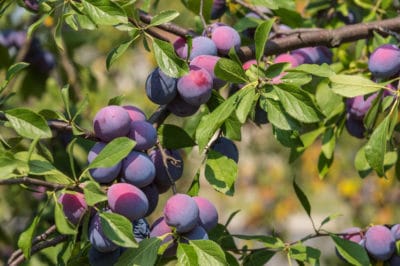Caring for Different Types of Plums
Plums come in many cultivars, and they grow successfully in a wide range of locations in USDA planting zones 3 to 10.
Most plum varieties grown for fruit and landscaping belong to the groups of European plum (Prunus domestica) and Japanese plum (Prunus salicina).
European plum varieties are usually self-fruitful, so you can grow a single tree and still get fruit. Most Japanese plum varieties need a pollinator tree of a different type in order to set fruit.
Also, some varieties of European plum can be dried, but this is not true for Japanese varieties, and some types of Japanese plum are useful as hedge-rows in landscaping, unlike the larger, more upright growing European cultivars.
There are several other species of plum tree grown to a lesser extent but still important commercially and in backyard gardening. These include:
- Damson prunes (P. insititia) is a variety used in brandy making and for jam.
- American plum (P. Americanus) is a hardy, native variety with small fruit good for fresh eating.
- Canada plum (P. nigra) is a plum variety native to North Eastern America used for cross-pollination with Japanese plums, which also produces fruit useful for jams and pies.
The species and variety of plums, growing zone, and local weather conditions determine when the tree blooms, how much summer irrigation it needs, and whether or not the tree needs to be planted with other trees of a different variety in order to produce fruit.
Planting Plum Trees
Plant plum trees where they will receive full sun, and choose a location with well-drained soil and a pH in the range of 5.5 to 6.5. If your soil isn’t optimum, add compost and other amendments as needed and dig them deeply into the planting area before placing the tree.
Choose a location protected from cold winds and frost because plum trees bloom early and cold conditions can damage flowers and fruit production.
Buy plum trees from a local nursery, and purchase trees suited to your local planting zone, resistance to problematic diseases in your area, and with attention to cross-pollination requirements.
You can also grow your own plum trees from seed. However, you are unlikely to get a tree the same as the parent tree, so this is a more risky way of producing a new plum tree, if you want fruit.
